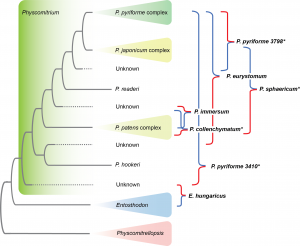 Patel N., R. Medina, L.D. Williams, O. Lemieux, B. Goffinet & M.G. Johnson. Frequent allopolyploidy with distant progenitors in the moss genera Physcomitrium and Entosthodon (Funariaceae) identified via subgenome phasing of targeted nuclear genes. Evolution 77: 2561–2575. pdf
Patel N., R. Medina, L.D. Williams, O. Lemieux, B. Goffinet & M.G. Johnson. Frequent allopolyploidy with distant progenitors in the moss genera Physcomitrium and Entosthodon (Funariaceae) identified via subgenome phasing of targeted nuclear genes. Evolution 77: 2561–2575. pdf
Abstract reads: Allopolyploids represent a new frontier in species discovery among embryophytes. Within mosses, allopolyploid discovery is challenged by low morphological complexity. The rapid expansion of sequencing approaches in addition to computational developments to identifying genome merger and whole-genome duplication using variation among nuclear loci representing homeologs has allowed for increased allopolyploid discovery among mosses. Here, we test a novel approach to phasing homeologs within loci and phasing loci across subgenomes, or subgenome assignment, called Homologizer, in the family Funariaceae. We confirm the intergeneric hybrid nature of Entosthodon hungaricus, and the allopolyploid origin of Physcomitrium eurystomum and of one population of P. collenchymatum. We also reveal that hybridization gave rise to P. immersum, as well as to yet unrecognized lineages sharing the phenotype of P. pyriforme, and P. sphaericum. Our findings demonstrate the utility of our approach when working with polyploid genomes, and its value in identifying progenitor species using target capture data.
